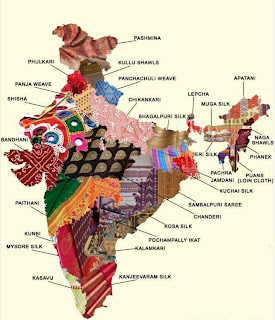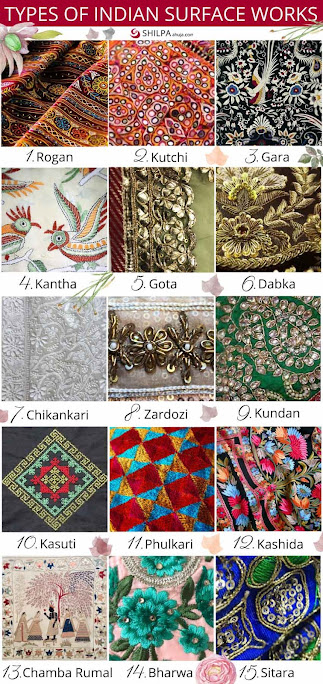Indian Traditional Handloom Textiles
- Get link
- X
- Other Apps
Indian Traditional Handloom Textiles
4 main types of Indian handloom textiles
1) Embroidered textiles
Embroidery is the art of needlework resulted from the passion of womenfolk to express their creativity and ornament their apparel, saree, fabric and household textiles. Primarily a feminine art, young girls learned the craft from their mothers and older women in the family. The artistic expressions of the embroiderer are skillfully created on fabric with a simple tool, needle or a hook needle known as awl or tambour. Different embroidery styles have developed regionally in India that has a distinct identity of their own. Cotton, silk, woolen thread or gold/silver is used to embroider on various media, from cotton, silk, woolen fabric to velvet and leather. Besides thread, pieces of fabric, beads, mirrors, shells, coins, precious stones and sequins are also used for embellishing the fabric. With the passage of time, a variety of embroidery designs have been created by artisans from their own imagination and as per todays fashion demand.
a) Kashida from Kashmir
Kashida defines its cultural essence through the medium of bead and thread work, which has gained maximum popularity, fame and recognition in the ethnic land of Jammu and Kashmir. The purest essence and forms of nature. Motifs used like birds, leaves, trees and many such natural designs are replicated in this embroidery with multi colored threads and beads woven into the fabrics like shawls and saris.
Video which explain more about kashida embroidered textiles from India, please find the link below www.kashidaembrideredfabric.com
b) Phulkari from Punjab
Phulkari, the geometric, colorful and traditional embroidery of Punjab is a handcrafted practiced exclusively done by women. Translated as phul (Flower) and Kari (the artwork, motifs or design). Phulkari is used in both daily and occasional attire in form of dupatta, handbag and Patiala suits. The .embroidery or stiches gives it a rich mosaic. The finest decorative work is done in this phulkari pattern called Bagh, and the predominant geometric designs covered the entire surface of the background cloth .This intricate work was done for special occasions using - effect with unique untwisted silk thread in bright colors using geometric patters or floral designs.
c) Chamba rumal from Himachal Pradesh
Chamba rumal literally means handkerchief in Hindi . Chamba Rumal is a handicraft of embroidered handkerchief, originated in chamba , Himachal Pradesh. Embroidered Rumals were usually gifted on a daughter wedding ,which was customary in Himachal Pradesh hills or valleys. This beautifully done embroidery and stiches uses simple natural motif for example tree, flower, fruits etc. in bright color. It also features intricate motifs like mythological scenes, Raas - Leela , Hunting and wedding scenes. Both men and women use these Rumals and shawls. The way embroidery they did that the both sides of the designs and stitches are identical .They keep embroidered Rumal as heritage for future generations and used in ceremonial presentations.
d) Chikankari from uttar Pradesh
Chikankari is a unique way of designing fabric. It's an arduous process that is a compilation of designing, engraving, block printing, embroidery, washing and finishing. First, the fabric is cut according to requirement and then it is block printed with design motifs on which the embroidery is done. Six basic stitches combined with 40 different styles give it new patterns like Murri , Phanda (French Knots), to the most popular jaali work (Trellis), and Bakhiya (shadow stitch). Motifs based on nature such as flowers, paisleys, peacocks, etc. are commonly used. Traditionally, it was only made on whites but nowadays it is available in all colors. It is a delicate hand embroidery found on a large range of fabrics that include chiffon, muslin, silk, organza, net, cotton, etc. It is a detailed form of embroidery that often uses motifs of Mughal architectural theme.
g) Zardozi from uttar Pradesh
h) Kasuti from Karnataka
i) lambadi embroidery from andhra Pradesh
j) Kantha from West Bengal
k) Sujani from Bihar
l)Pipli appliqué from Orissa
- Get link
- X
- Other Apps






Comments
Post a Comment